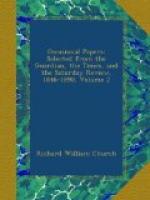Such an informant presents a picture entirely different in kind from the comments and criticisms of those who can judge only from Mr. Keble’s writings and religious line, or from the rare occasions in which he took a public part. These appearances, to many who willingly acknowledge the charm which has drawn to him the admiration and affection of numbers externally most widely at variance with him, do not always agree together. People delight in his poetry who hate his theology. They cannot say too much of the tenderness, the depth, the truth, the quick and delicate spirit of love and purity, which have made his verses the best interpreters and soothers of modern religious feeling; yet, in the religious system from which his poetry springs, they find nothing but what seems to them dry, harsh, narrow, and antiquated. He attracts and he repels; and the attraction and repulsion are equally strong. They see one side, and he is irresistible in his simplicity, humbleness, unworldliness, and ever considerate charity, combined with so much keenness and freshness of thought, and such sure and unfailing truth of feeling. They see another, and he seems to them full of strange unreality, strained, exaggerated, morbid, bristling with a forced yet inflexible intolerance. At one moment he seems the very ideal of a Christian teacher, made to win the sympathy of all hearts; the next moment a barrier rises in the shape of some unpopular doctrine or some display of zealous severity, seeming to be a strange contrast to all that was before, which utterly astonishes and disappoints. Mr. Keble was very little known to the public in general, less so even than others whose names are associated with his; and it is evident that to the public in general he presented a strange assemblage of incoherent and seemingly irreconcilable qualities. His mind seemed to work and act in different directions; and the results at the end seemed to be with wide breaks and interruptions between them. But a book like this enables us to trace back these diverging lines to the centre from which they spring. What seemed to be in such sharp contradiction at the outside is seen to flow naturally from the perfectly homogeneous and consistent character within. Many people will of course except to the character. It is not the type likely to find favour in an age of activity, doubt, and change. But, as it was realised in Mr. Keble, there it is in Sir John Coleridge’s pages, perfectly real, perfectly natural, perfectly whole and uniform, with nothing double or incongruous in it, though it unfolded itself in various and opposite ways. And its ideal was simply that which has been consecrated as the saintly character in the Christian Church since the days of St. John—the deepest and most genuine love of all that was good; the deepest and most genuine hatred of all that was believed to be evil.




